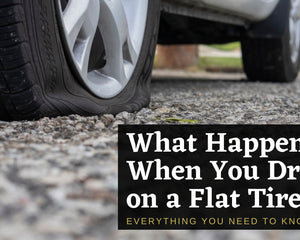
According to a study conducted by the National Highway Traffic Safety Administration, only 57% of motor vehicles that had tire pressure monitoring systems fitted had correctly inflated tires, which means that these systems are defective, or inaccurate 43% of the time.
So do you rely on your tire pressure monitoring system to alert you to the fact that you have incorrectly inflated tires, or do you rely on your mechanic to check your tire pressures during oil changes?
Whichever of these methods you use, you are wasting gas and reducing the life of your tires, but worse, you could be placing the lives of your family at risk.
The study also found that 50% of crashes that are caused by tire related problems involved only one vehicle, and that only 31% of single-vehicle accidents did not have tire-related causes. The last thing we want is for you to become part of these statistics, so to this end, we have compiled a list of four major reasons why it's essential for every driver to keep accurate tire pressure gauges handy in every car for maintaining proper tire inflation and preventing the unexpected.
1. Incorrect tire pressure increases fuel consumption

Tires have to be inflated to specific pressures to provide maximum traction, but even correctly inflated tires offer a certain amount of resistance to movement because of friction, contact area with the road, construction, and the rubber compounds they are made of, and collectively, these factors are referred to as “rolling resistance”.
These factors, and a myriad others, determine how much energy in the form of fuel is required to keep a car moving, so if the tires are under-inflated, their contact area with the road increases in direct proportion to the amount of under inflation. Thus, a larger contact area offers more rolling resistance, which requires more fuel to overcome. While it is impossible to provide accurate figures for all cars under all conditions, it is widely accepted that properly inflated tires can save you as much as 3% - 4% in fuel costs over any given period.
2. Incorrectly inflated tires increase stopping distances
inflated tires increase stopping distances
Contrary to what you may have heard or read, it is not the brakes that stop a car - it is in fact that the tires, since they slow the car down through friction with the road surface. However, all tires deform under extreme braking forces, and this fact is allowed for in brake and suspension design, but under inflated tires deform to the point where the braking forces overcome traction, because the tire tread is not in full contact with the road.
On the other hand, over inflated tires may not deform as much, but over inflation also causes a reduction in the contact area with the road due to the bulging of the centre portion of the tread. In both cases, the tire is not able to maintain sufficient traction because there is less rubber in contact with the road than there should have been. The result is a dangerous increase in stopping distances, which is a leading cause of otherwise avoidable crashes.
3. Incorrect inflation causes poor steering control

As with braking, the tires depend on proper inflation to limit the amount of deformation experienced during cornering. Under cornering forces, an under inflated tire can deform to the point where the inner tread edge of the outside wheel is actually lifted off the road surface, which means that only half of the tread is available to bear the cornering loads.
The result is severe over steer, which means that the car does not follow the line dictated by the steering angle. In a case of severe under inflation, the car can refuse to turn, no matter the steering angle, but worse, the tire can peel off the rim- in which case a crash is almost inevitable.

4. Incorrect inflation causes blow-outs
All tires flex and deform under normal driving conditions, but the sidewalls of under inflated tires flex so much that the entire tire starts to overheat. This overheating causes a rapid deterioration of the reinforcing bands in the sidewall, which could rupture unexpectedly as a result.
While under inflation by 25% triples the risk of this type of tire failure, under inflation by more than 25% increases the risk of tire failure exponentially. Bear in mind that tire pressure monitoring systems only trigger a warning light when under inflation reaches 25%, at which point you are already three times as likely to experience a blow-out, which goes to prove that you cannot rely on the TPMS alone to keep you safe.
A final thought...
The only sure way to maintain proper tire pressures is to check all your tires at least once a week with a high quality, certified accurate tire pressure gauge. However, the pressure difference between hot and cold tires can be as much as ten pounds per square inch, so only check your tire pressures when the tires are cold, and always use a reliable gauge made by a reputable manufacturer, like JACO, to ensure consistently accurate readings.


 inflated tires increase stopping distances
inflated tires increase stopping distances


